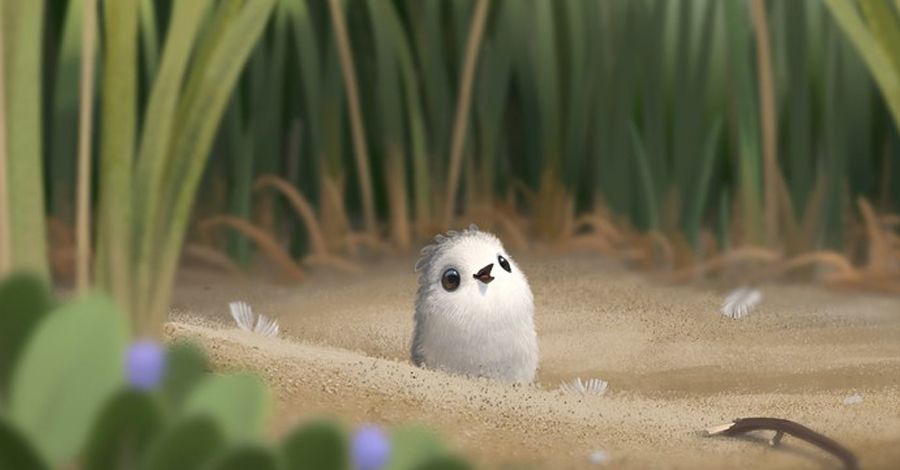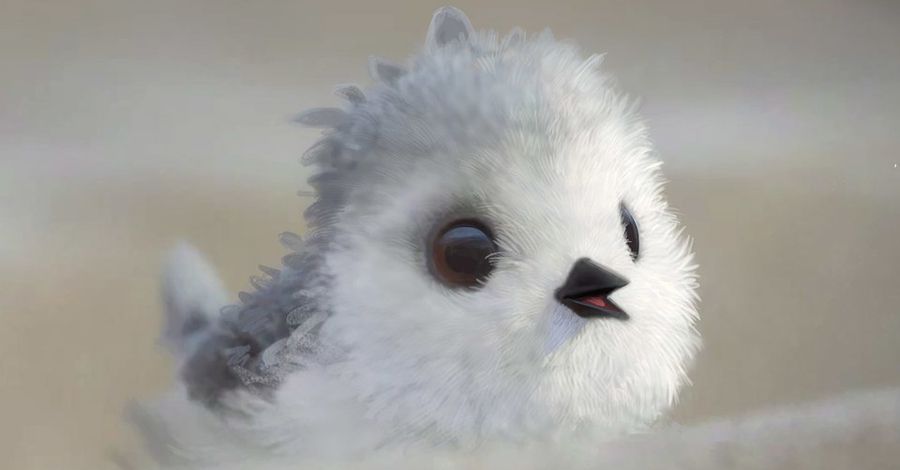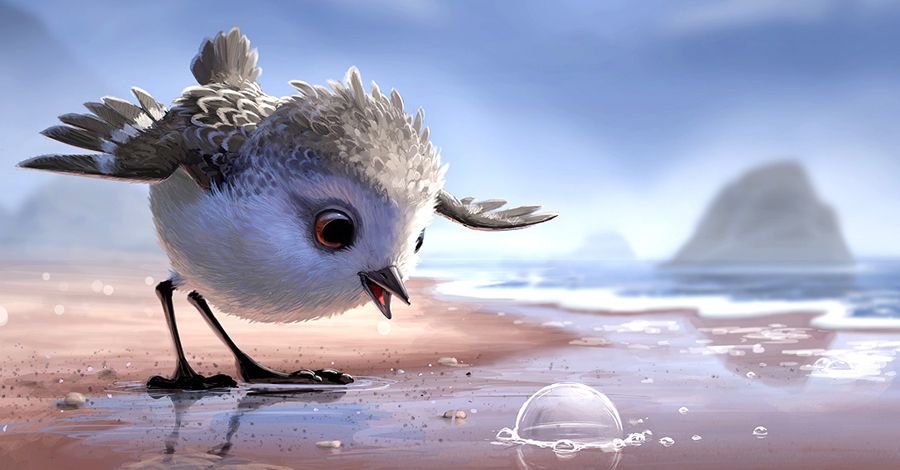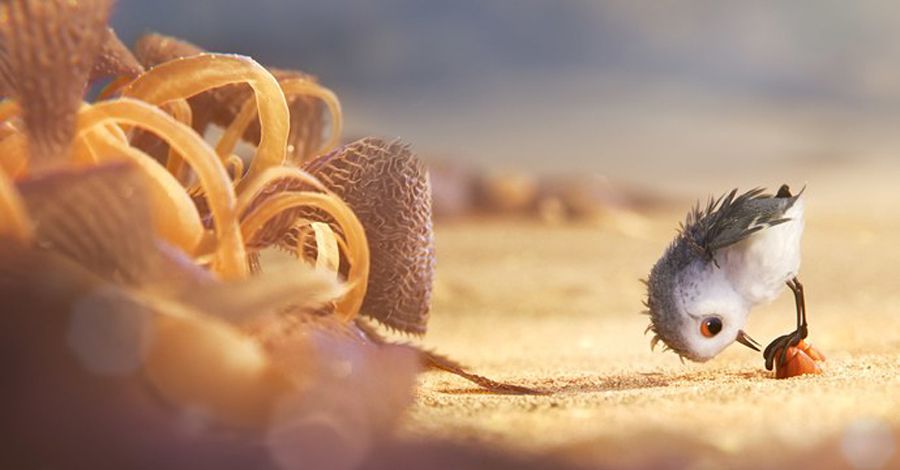Pixar’s new animated short “Piper,” which centers on the adventures of an adorable, nearly photorealistic baby sandpiper, makes for a splashy debut for a filmmaker within the studio’s ranks.
In theaters with “Finding Dory,” the six-minute short is directed by Alan Barillaro, a longtime member of the Pixar team whose credits as an animator and animation supervisor include “Finding Nemo,” “The Incredibles” and “Brave.” It’s a project that sprang from his efforts testing new technical tricks and grew into one of the studio’s most charming and heartwarming shorts.
Joined by producer Marc Sondheimer, Barillaro sat down with Spinoff Online to discuss how a test of technology turned into a labor of love.
Spinoff Online: I understand that this really started out as sort of a technological experiment. Tell me what you were trying to achieve and why you saw it take on a whole extra life.
Alan Barillaro: I’m an animation supervisor by day. You’re always trying to improve on the tools. I had a bunch of minor improvements I was playing with. One of them which was shaping characters and kind of very quickly coming up with new characters. So I had a test of a little sandpiper running away from little waves, thinking it was just a pure exercise of that technical challenge.
Andrew Stanton [director of “Finding Nemo” and “Finding Dory”] saw it and really encouraged me to push on the story aspect of that idea. And hence, the process began, which was really wonderful. John Lasseter of course too was supportive and saying, “Keep developing the story.” I had the bones of the story in mind, but more of my own way of thinking initially had no intention of being a short film at all.
How does the process work? How do you take a creative notion like that and then turn it into an official project you’re going to go forward with? Can you give me a sense of what that’s like?
Marc Sondheimer: You know, this was unique, right? Normally the shorts, they come out of a development group and you pitch ideas to John, and he blesses one. This, I think, got the support via a test of the studio to actually go make it, so it was kind of a very different pipeline, if that’s kind of what you’re asking. It happened … I think it’s in some ways because of Alan’s relationship with Andrew.
Barillaro: It’s very Pixar, I guess is what I’d add. I think that’s the culture they breed there. And John, it’s not a hard sell to say, I’m going to try to invade as much as I can on this. Maybe a story is there. I felt really safe to take that risk and push on story. So they’re very supportive and probably don’t get enough praise for how much they mentor us as artists. It’s less of a business model and more of a passion.
"Finding Dory" Stars Voice Their Thoughts on the Film's Themes and Forgetfulness
John’s love of short films and care for the medium really resonates, and you feel it when you meet with him. It’s not about anything else other than “Is there something amazing that we could make here?” You feed off that. You go back to your desk and you try to do that.
So on a practical sense, I started storyboarding with some story artists and putting those reels up, because story matters to us more than anything. So the same time I was doing technical tests, I was working on the story.
What struck me I think maybe the most about this one as opposed to the others is the extreme degree of photorealism -- and yet they’re also fully characters, and comedic, and they live in a cartoon world. Tell me about that super -fine line, in this particular short, of achieving that.
Barillaro: Yeah, thank you. It was a fine line. You have to kind of cross it to know the boundaries. For me, maybe this will sound odd, but [Norman] Rockwell was a huge touchstone for me, guiding me through that. I always like to reference classical work. You’ll see it there, always: really smart visual storytelling; a lot of manipulation to the composition. But Rockwell in general, it’s all about character. Everything was to service the humor and the charm of the character.
At first glance, it looks real. And then you start looking at a Rockwell painting and realize, “Wow, that composition is very forced. The colors are a bit ridiculous. The hands are really big.” And yet, you fully believe it. So that was definitely kind of an inspiration for me on getting the look of Piper.
I imagine you spent a lot of time looking at real birds and sea creatures and the environment. Tell me how that observational experience really enhanced what you ended up with creatively.
Barillaro: Always does, because I feel like you get to a more honest performance when you see something that you can reference and audiences can relate to, it’s usually because you’ve done your homework. A little bird flutter feels like a shiver, or a shiver of excitement. I think we catalog at Pixar in the back of our minds all those ideas so that it’s a unique new performance and a unique character, versus just generic kind of iconic attitudes of expression. Hopefully that makes that character even more true to the audience.
For you, Marc, what’s unique as a producer of shepherding a short-form film like this as opposed to one of the bigger ones?
Sondheimer: You have to be scrappy. Very, very scrappy. I mean, the shorts are labors of love, I feel like. Everything that people do at Pixar in a lot of ways is … they’re craftspeople. But in no greater way do you see it than on the shorts, in my opinion. The feature films have acclaim, they’ve got a lot of support, they get notoriety out in the world. The short films are truly like a lot of craftspeople in it for the pure joy of filmmaking.
REVIEW: "Finding Dory" Delivers an Inspiring Message in a Colorful Adventure
I love that Pixar supports that and continues to make it. It’s hard because you’re trying to get people while two feature films are going on. They want all the people they can possibly get. You need to be resourceful and creative about how you approach the filmmaking, actually. It really is just a beautiful aspect of Pixar, I feel.
I’ve gotten that impression that working on feature films for both Pixar and Disney, you get a lot of feedback constantly from your colleagues and your peers – like, you’re constantly showing them new bits, new versions. But for the shorts, is it really going off into your own corner with your team and putting it together just the way you see it?
Barillaro: Yeah, maybe in that sense, because the team is so much smaller, it’s that little team’s perspective, and we’ve all done the exact same thing we would in a big structure except, we’re all in the same room, and I found that to be a really wonderful experience. So hopefully the film “Piper” will come across a little bit more personal, at least to me.
I think every film is personal. But I guess what I’m trying to get at is, it’s a great dynamic to have to work on a film where you’re lucky enough to fit in the same room and kind of feed off every department. It’s wonderful to be part of the big features, but to have that little time and space to work really intimately with colleagues is fun.
Was there something that at first seemed very challenging, but in the end turned out to be something that you’re really pleased with?
Barillaro: You know what? We took on everything with this one. I remember the advice was, “OK, just pick one: You can do feathers, you can do sand and [you can do] water. You can’t pick three.” I have to thank the crew for being so brave and fearless. They just said, “Let’s try for all three!”
It was daunting. The more reference we did … This is pretty complicated stuff! We’ve never done this before. But that’s exactly what’s exciting. When you’re on a picture where you feel like, we haven’t seen this before, it’s exactly I think that’s what makes it [worth doing]. And it’s in our DNA to go, “Well, then, we’ve got to of course go for it.”
So I don’t know if folks realize how much we don’t go into these ideas without a blueprint or a map, how to get out of it. But it’s always an exciting challenge to try. We had to come up with all new processes of doing water at that macrophotography look and those detail levels. How to animate waves and feathers were all kind of new techniques for us, for “Piper.”
Is there an ambition on your part to take the technique that you’ve mastered here and blow it up to feature-length and take that approach to a bigger story?
Barillaro: Right now, I think there’s a pause! It’s taking a breath and getting some rest. It hasn’t even been a month that we finished it. [Laughs]
Sondheimer: I’d say, the collaborative way that we work with people in different departments all together in a room is always something that we try and bring to every project. It’s hard to do it on features because the departments are much bigger. But, like, if we can just grab some of that, some of those elements of collaboration and honesty in the room to larger projects, that will be something that I’ll definitely strive to do as I move forward.
Did you also in a sense build a toolbox that everyone at Pixar can now like reach into, in the things that you were pioneering on this one? That the whole company can now take advantage of?
Barillaro: Yeah, and vice versa. “Finding Dory,” we were in the wake of their beautiful work as well and some of the stunning things that they did is a direct relationship to us. And that’s fun. Having a community of artists where you share is so much better, and passing around. So we’d figure out something, we’d run off, and hopefully we’ll pass that along as much as possible. But it’s always nice to get that, too: “Oh, wow, thank you!” So yeah, paying it forward.
Being such a fan of the Pixar shorts and the history of Disney shorts, I thought this thing felt like it had a Disney soul, which is always the trick. Tell me about getting there and coming away feeling like that: like you told a story that fit in the Disney legacy with all the tools at your disposal.
Barillaro: Well first off, that’s a huge compliment, so thanks. And that is a high bar. So it was something that we’ve cared deeply about and respect. “The Little Whirlwind” is probably my favorite – it is my favorite animated short ever, Disney animated short. That tone of ease of watching and appeal was a lot of what inspired me, too, for this short. So yes, classic Disney shorts, if you put “Piper” even near that …
Sondheimer: I feel like it’s standing on the shoulders of giants. You know that feeling, where it’s like a little bird standing on the shoulders of giants? You think about that legacy is …
Barillaro: Intimidating.
Sondheimer: Intimidating! [Laughs]




